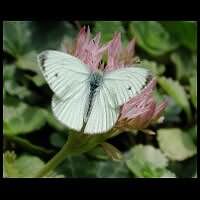Introduction to Butterflies (Lepidoptera)
Like moths, butterflies are Lepidoptera, a huge group of insects. Some 120,000 species are known to man, but there is little doubt that perhaps the same number of species is still waiting to be discovered. All lepidoptera have rather large wings covered with scales and some species are without any doubt among the most beautiful creatures on earth. The name is derived from Ancient Greek 'lepidos' (scale) and 'pteron' (wing). A person who collects or studies this order is referred to as a lepidopterist.For a very long time this order has been split up in two groups: butterflies and moths. Scientifically however the two groups do not exist. Since even lepidopterists continue to use this distinction Gardensafari uses it as well. One of the differences between the these groups is that the front and hind wings of moths are connected, which is not the case in butterflies. Butterflies therefore can operate the two pairs of wings separately. Another visible feature is the way the antennae are constructed. All butterflies have long, thin antennae with a little knob on top. Some moths also have a wirelike antenna, but it never has the knob on top! Most moths however have antennae which are more complicated: some look like combs, others like brushes and some are five times as long as the insects body. Another distinctive features are the wing patterns and coloration.
A vast majority of butterflies fly during daytime, but some fly during the night as well. Most moths are nocturnal animals, active during the night and resting during the day. Butterflies are often very colourful. Often the underside of the wing differs completely from the upperside. When butterflies sit on one spot for a longer period of time they have a habit of regularly opening and closing their wings. This is defensive strategy of butterflies that confuses their preditors. The enemies can't get a visual estimate of the body parts of its victim and thus do not know where to strike.
Admirals (Nymphalidae)
Most of the more colorful and larger butterflies in Europe belong to this family.
Click here to select a specific species.
Most of the more colorful and larger butterflies in Europe belong to this family.
Click here to select a specific species.
Whites (Pieridae)
This family of butterflies is usually called The Whites. Not all members are white, for some are orange or yellow. The family is very common in the moderate temperature zones of the world.
Click here to select a specific species.
This family of butterflies is usually called The Whites. Not all members are white, for some are orange or yellow. The family is very common in the moderate temperature zones of the world.
Click here to select a specific species.
Browns (Satyridae)
The family of Browns is composed of Satyrs and Wood Nymphs. All are brownish butterflies showing eye-shaped spots, usually on both sides of both wings.
Click here to select a specific species.
The family of Browns is composed of Satyrs and Wood Nymphs. All are brownish butterflies showing eye-shaped spots, usually on both sides of both wings.
Click here to select a specific species.
Blues and Coppers (Lycaenidae)
The family of the Lycaenidae is generally referred to as Blues. True, a number of species are blue indeed, but they are only a portion of all species within this family.
Click here to select a specific species.
The family of the Lycaenidae is generally referred to as Blues. True, a number of species are blue indeed, but they are only a portion of all species within this family.
Click here to select a specific species.
Skippers (Hesperiidae)
Skippers all resemble one another. They can easily be distinguished from other butterflies by their relatively robbust body and rather small wings.
Click here to select a specific species.
Skippers all resemble one another. They can easily be distinguished from other butterflies by their relatively robbust body and rather small wings.
Click here to select a specific species.


© Copyright 1998-2024 gardensafari.net (Hania Berdys)

 English / engels
English / engels  Dutch / nederlands
Dutch / nederlands



